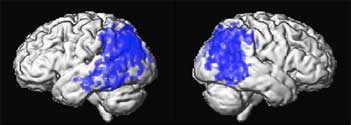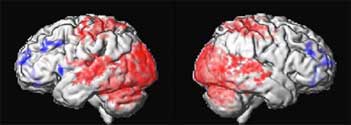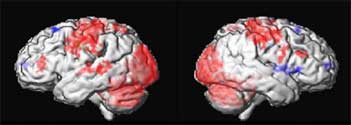I can't remember the last time I got this excited about neurosurgery! : )
A team of scientists are using 'Functional Neurosurgery' to perform "deep brain stimulation" using electrodes implanted in the brain to treat disorders of movement (Parkinsons, Dystonia, etc), mood (Depression, etc), and cognition (Alzheimers, Schizophrenia, etc).
Discussed at:
04:22 - patient w/parkinsons disease (before and after)
05:37 - patient w/dystonia (before and after)
07:59 - depression
10:26 - can "deep brain stimulation (DBS)" be used to make you *smarter*?
Adjusting Dials on Circuits in the Human Brain: Andres Lozano at TEDxCaltech
Andres M Lozano, BSc, MD, BMedSci, FRCSC, PhD
http://www.uhnresear...php?lookup=3678





Normal Brain, Mild Cognitive Impairment, Alzheimer's Disease

Decreased metabolism in AD compared to controls

One month of DBS compared to baseline

One year of DBS compared to baseline
Positron emission tomography scans of 6 patients with Alzheimers disease showing areas of decreased glucose utilization before surgery in blue which are reversed with DBS after 1 month or 12 months of DBS. Restoring glucose utilization suggests that these brain areas that were shut down are once again active.
A Phase I Trial of Deep Brain Stimulation of Memory Circuits in Alzheimer’s Disease
Adrian W. Laxton, MD,1
David F. Tang-Wai, MDCM, FRCPC,2,5 Mary Pat McAndrews, PhD,3
Dominik Zumsteg, MD,4
Richard Wennberg, MD, FRCPC,5
Ron Keren, MD, FRCPC,2
John Wherrett, MD, FRCPC,2,5 Gary Naglie, MD, FRCPC,2
Clement Hamani, MD, PhD,2
Gwenn S. Smith, PhD,6
and Andres M. Lozano, MD, PhD, FRCSC1
Objective: Alzheimer disease (AD) is characterized by functional impairment in the neural elements and circuits
underlying cognitive and memory functions. We hypothesized that fornix/hypothalamus deep brain stimulation (DBS)
could modulate neurophysiological activity in these pathological circuits and possibly produce clinical benefits.
Methods: We conducted a phase I trial in 6 patients with mild AD receiving ongoing medication treatment. Patients
received continuous stimulation for 12 months. Three main lines of investigation were pursued including: (1) mapping
the brain areas whose physiological function was modulated by stimulation using standardized low-resolution
electromagnetic tomography, (2) assessing whether DBS could correct the regional alterations in cerebral glucose
metabolism in AD using positron emission tomography (PET), and 3) measuring the effects of DBS on cognitive
function over time using clinical scales and instruments.
Results: DBS drove neural activity in the memory circuit, including the entorhinal, and hippocampal areas and
activated the brain’s default mode network. PET scans showed an early and striking reversal of the impaired glucose
utilization in the temporal and parietal lobes that was maintained after 12 months of continuous stimulation.
Evaluation of the Alzheimer’s Disease Assessment Scale cognitive subscale and the Mini Mental State Examination
suggested possible improvements and/or slowing in the rate of cognitive decline at 6 and 12 months in some
patients. There were no serious adverse events.
Interpretation: There is an urgent need for novel therapeutic approaches for AD. Modulating pathological brain
activity in this illness with DBS merits further investigation.
http://www.societyns...9;s disease.pdf
Article:
Deep Brain Stimulation to Improve the Mind
http://www.surgicals...LozanoBrainStim
Edited by MonkeySeeMonkeyDo, 12 March 2013 - 02:47 PM.














































